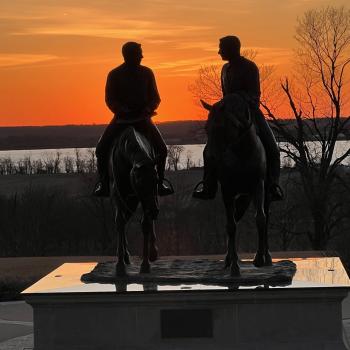Most people say that Easter is the highest observance of the Christian calendar. Yet, Christ’s ascension is more theologically compelling.

In the incarnation, God identifies with humanity by becoming one of us. As Jesus suffers martyrdom on a Roman cross, he embodies God’s love even for those who make themselves enemies. At the resurrection, Jesus demonstrates victory over death and foreshadows a promised resurrection of the saints. But Christ’s ascension marks the apex of his ministry. For this reason, I find the ascension far more gripping.
This year (2025), Ascension Day is May 29, forty days after Easter. In preparation, let’s take a look at the lectionary scriptures that mark this special occasion:
Luke 24:50-53
If the resurrection is an emergence from six feed under the ground, back to surface level, the ascension marks a far greater journey. The Gospel writer depicts an ascension that is not only a departure from this earthly realm, but also from anything the disciples have seen before.
50 Then he led them out as far as Bethany, and, lifting up his hands, he blessed them. 51 While he was blessing them, he withdrew from them and was carried up into heaven. 52 And they worshiped him and returned to Jerusalem with great joy, 53 and they were continually in the temple blessing God.
Whether Luke intends to depict a Jesus who flies into the clouds, or a cosmic Christ who dematerializes into a heavenly dimension, one thing is certain: This resurrected and ascended one is worthy of worship.
Remember—Jesus was not the only person the disciples had ever seen risen from the dead. Emptying graves was a hallmark of Jesus’s ministry, a miracle they had witnessed over and over in the past three years. Sure, those whom Jesus resuscitated never had glorified bodies as Jesus did—but, like them, he stood on the ground and walked among them. This ascension thing was something entirely different.
Acts 1:1-11
The author of Acts highlights the fact that, while important, Jesus’s resurrection appearances only lasted for forty days.
1 In the first book, Theophilus, I wrote about all that Jesus began to do and teach 2 until the day when he was taken up to heaven, after giving instructions through the Holy Spirit to the apostles whom he had chosen. 3 After his suffering he presented himself alive to them by many convincing proofs, appearing to them during forty days and speaking about the kingdom of God. 4 While staying with them, he ordered them not to leave Jerusalem but to wait there for the promise of the Father. “This,” he said, “is what you have heard from me; 5 for John baptized with water, but you will be baptized with the Holy Spirit not many days from now.”
6 So when they had come together, they asked him, “Lord, is this the time when you will restore the kingdom to Israel?” 7 He replied, “It is not for you to know the times or periods that the Father has set by his own authority. 8 But you will receive power when the Holy Spirit has come upon you, and you will be my witnesses in Jerusalem, in all Judea and Samaria, and to the ends of the earth.” 9 When he had said this, as they were watching, he was lifted up, and a cloud took him out of their sight. 10 While he was going and they were gazing up toward heaven, suddenly two men in white robes stood by them. 11 They said, “Men of Galilee, why do you stand looking up toward heaven? This Jesus, who has been taken up from you into heaven, will come in the same way as you saw him go into heaven.”
The ascension marks an entirely new era with Christ on the throne and the Holy Spirit taking the wheel of the Church. This new church age is what the book of Acts is all about.
In addition, this scripture depicts heaven open to receive humanity, and earth prepared to receive the divine. In the ascension, we learn that heaven’s gates swing in both directions.
It Is Good That I Am Going Away
In my article, “Does the Holy Spirit Point to Jesus? Or the Other Way Around?” I discuss the reason why the ascension matters.
“Jesus wanted us to model our lives after his. Yet, Jesus never wanted us to make it all about him. He spent his three-year ministry preparing his followers to live without him. If he wanted it to be all about him, Jesus never would have left. He would have stayed in his resurrected body, hanging out on earth for the past couple thousand years to bask in our worship. But he didn’t do that. Instead, he said, “It is for your good that I am going away. Unless I go away, the Advocate will not come to you; but if I go, I will send him to you.” Jesus wanted his life to be an example for us, but he wanted the Spirit to guide us in his absence.”
The ascension makes room for the Holy Spirit’s emergence as the primary leader of the nascent Church. If Jesus had merely resurrected but not ascended, believers would be forced to make lengthy treks to see him. Either that, or he would be constantly occupied on Zoom calls. We would have no prayer to an omniscient Christ. But with the ascension, all things change. An omnipresent Christ hears our prayers, and an ever-present Holy Spirit guides our lives.
Ephesians 1:15-23
In his letter to the church at Ephesus, Paul writes that it is this ascended Christ who gives the Spirit of Wisdom and revelation.
15 I have heard of your faith in the Lord Jesus and your love toward all the saints, and for this reason 16 I do not cease to give thanks for you as I remember you in my prayers, 17 that the God of our Lord Jesus Christ, the Father of glory, may give you a spirit of wisdom and revelation as you come to know him, 18 so that, with the eyes of your heart enlightened, you may perceive what is the hope to which he has called you, what are the riches of his glorious inheritance among the saints, 19 and what is the immeasurable greatness of his power for us who believe, according to the working of his great power.
Further, Paul highlights this enthronement of Christ in heaven. In the incarnation, Jesus was limited in time and space, clothed in human flesh. In the resurrection, Jesus’s body was glorified yet still limited by geography and chronology. It is in the ascension that Christ disrobes fully, exchanging even glorified flesh for omnipresence. Paul’s letter to the Ephesians continues:
20 God put this power to work in Christ when he raised him from the dead and seated him at his right hand in the heavenly places, 21 far above all rule and authority and power and dominion and above every name that is named, not only in this age but also in the age to come. 22 And he has put all things under his feet and has made him the head over all things for the church, 23 which is his body, the fullness of him who fills all in all.
To be “seated with him at his right hand in the heavenly places” is symbolic language that allows us to picture Jesus’s ascendancy. Yet, this heavenly throne is no fancy chair in the clouds. It is none other than Christ’s pre-eminence over all things. When we say that he “fills all in all,” we mean that Jesus is no longer bound by earthly limitations. Christ is one with all things, and all things are one with him.
Why Christ’s Ascension is Greater Than the Resurrection
Unfortunately, Ascension Day doesn’t get as much attention as Easter. Yet, without the ascension, Christ’s resurrection would be incomplete. Both are important. But I would argue that the transition from underworld to world is not as great as Christ’s transformation from terrestrial to celestial.
Jesus’s ascension crowns him as heavenly King. If his resurrection foreshadows our own, then his ascension presages ours as well. If the resurrection shows that Jesus is alive, then the ascension demonstrates that life is eternal. Both the resurrection and ascension are necessary. But while the resurrection shows Jesus’s victory, the ascension makes our victory possible.
For related reading, check out my other articles:
- Neurotheology: Is Spiritual Experience All in Your Head?
- Does God Change God’s Mind? The Bible Appears Confused…
- Wrestling With God: When My Faith Contradicts Itself

















